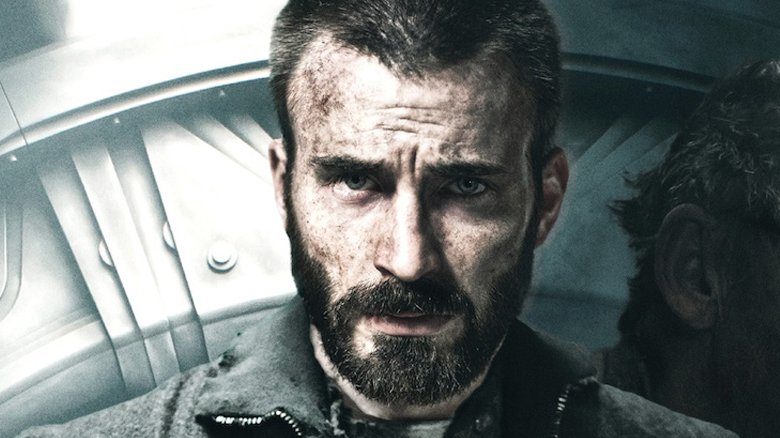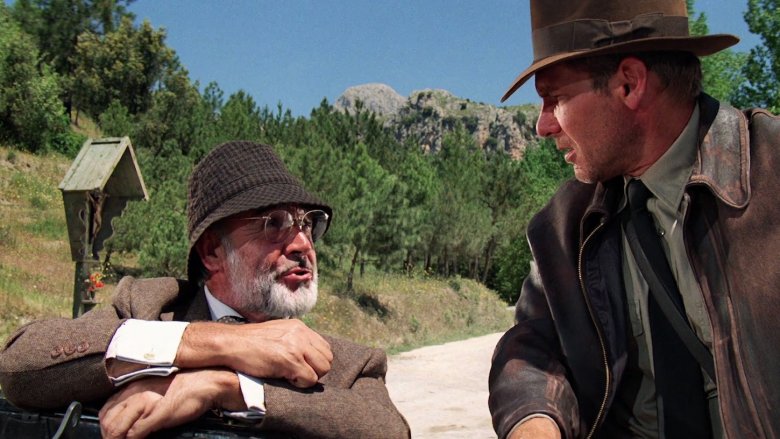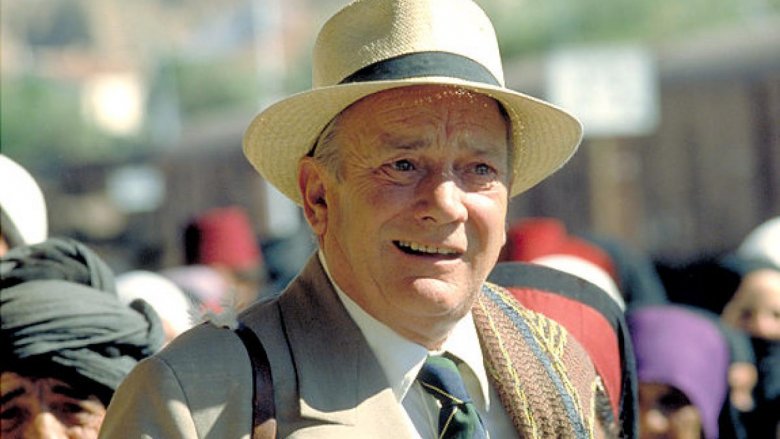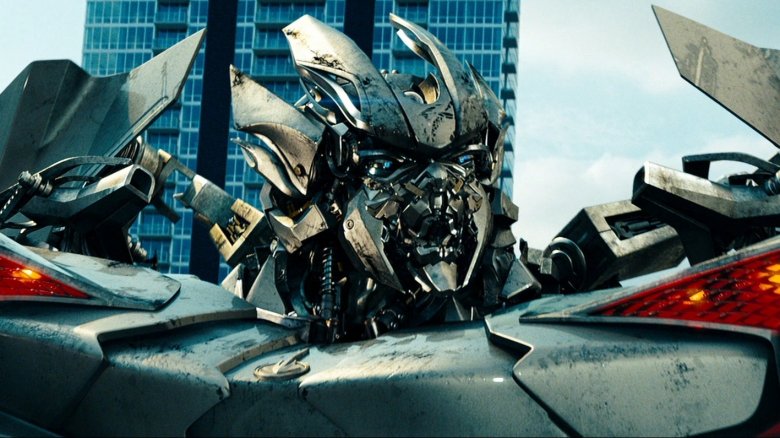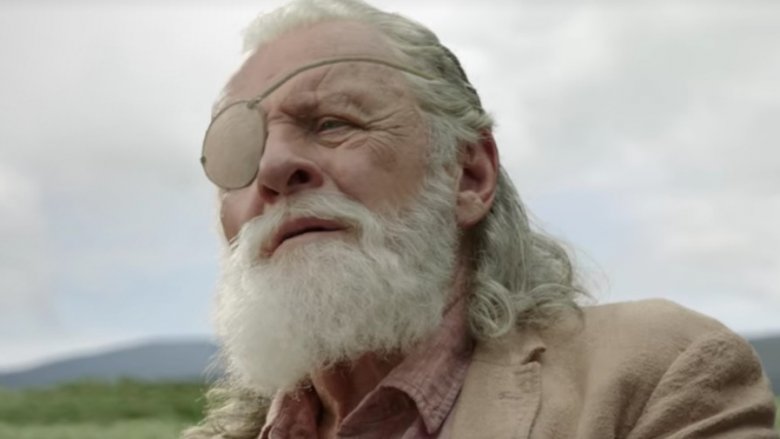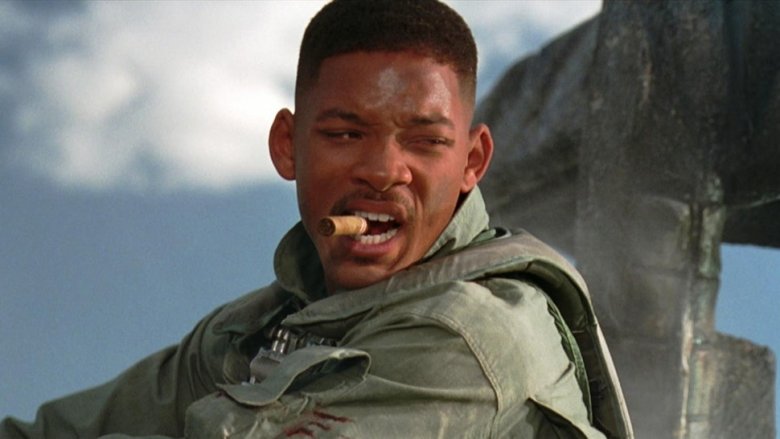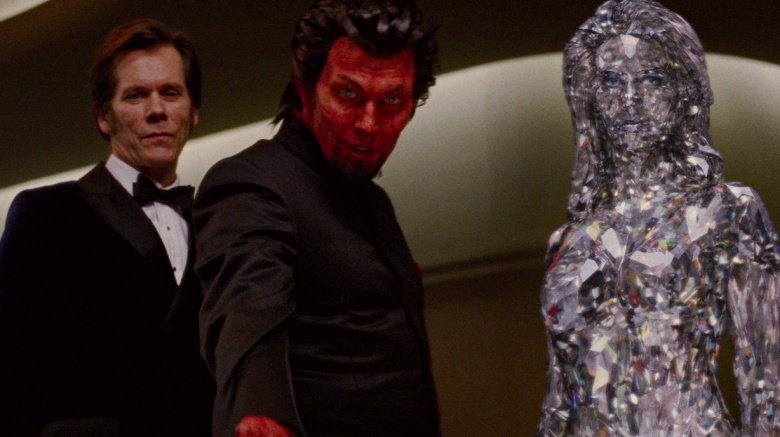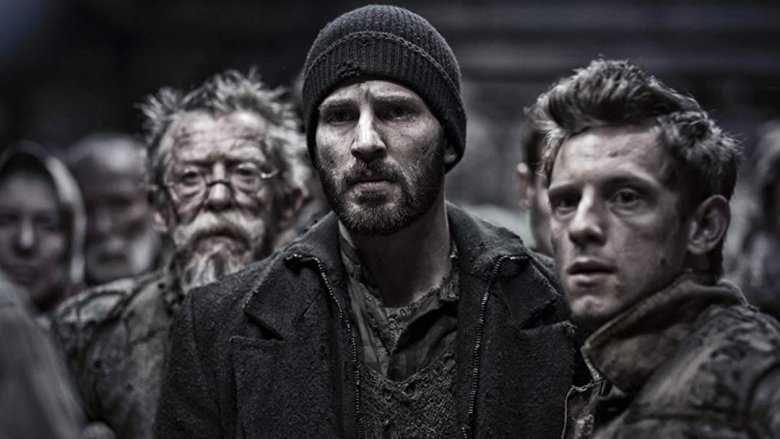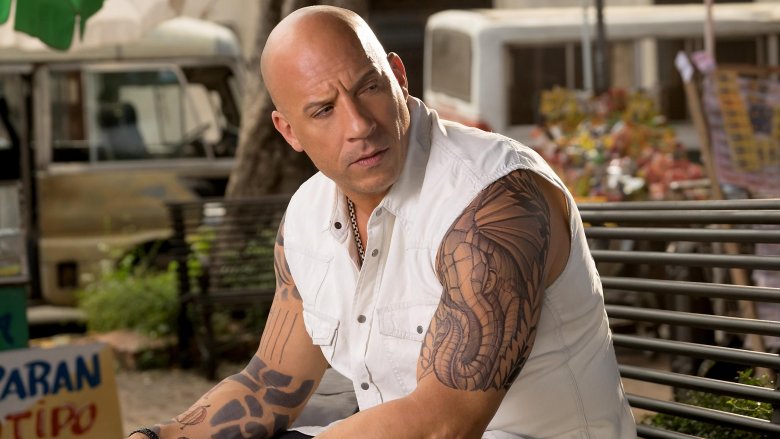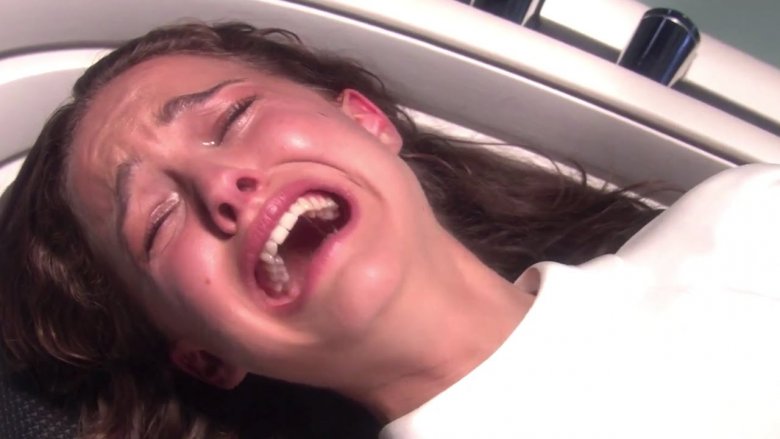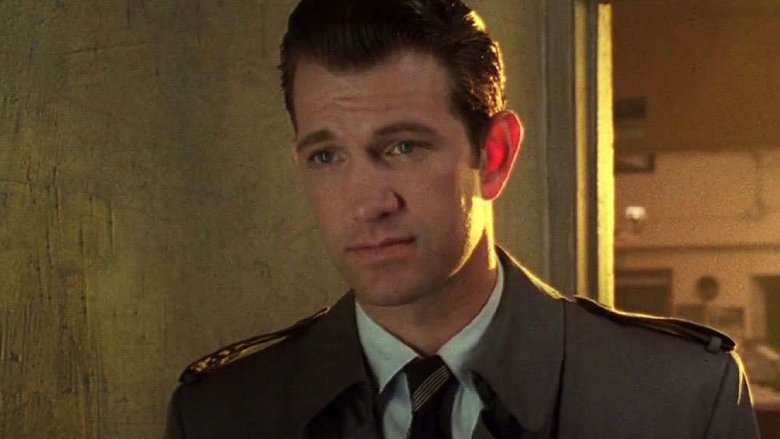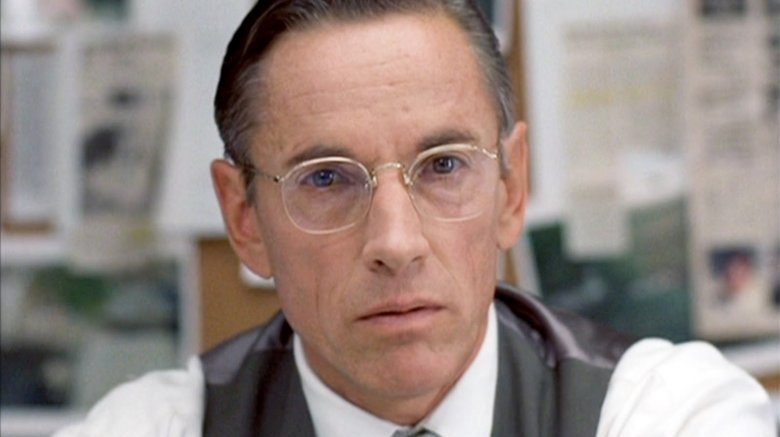Movie Deaths That Were Never Actually Explained
Death is as commonplace in film as green screens and fake facial hair. Even in genres that don't revolve around violence — like romance, drama, or comedy — there's a really good chance no matter what movie you see that at least one character you meet in the beginning won't survive to the end of the film.
But in some cases, there can be a lot of confusion surrounding the death of a character. We might hear about their death in exposition without it ever being explained. Or we might see their death, but the filmmakers either don't do a good job explaining how they died, or they've left the matter intentionally vague. Sometimes we don't even know if a character has died, just that they aren't around anymore. Often, the filmmakers are initially considerate enough to let us know what happened, but for whatever reason, that explanation is destined for the cutting room floor.
For examples of all of these and more, keep reading to learn about some of the many movie deaths that were never truly explained.
What exactly happened to Professor Henry Jones?
In Indiana Jones and the Kingdom of the Crystal Skull, Sean Connery didn't return as Professor Henry Jones, though he'd proven a welcome addition to the Indy franchise in Indiana Jones and the Last Crusade. Sadly, Professor Jones Sr. dies before Crystal Skull gets started, and in an early scene in the film, we see a framed photograph of the elderly professor on Indy's desk while mournful music plays.
Henry Jones' death is also confirmed in other media, though there's disagreement on the date. James Luceno's Indiana Jones: The Ultimate Guide says Henry dies in 1951, while James Rollins' novelization of Kingdom of the Crystal Skull puts his passing at around 1955.
We're apparently meant to assume Henry died of natural causes, but the events of The Last Crusade beg for a more specific explanation. In this film, the villainous Walter Donovan (Julian Glover) shoots Indy's father, leaving the Holy Grail as Henry's only possible salvation. Indy (Harrison Ford) finds the Grail, heals Henry's wound with it, and has him drink from the cup. Earlier in the movie, we're told the knights who discovered the Grail were alive 150 years after finding it, meaning the artifact bestows longer life. Taking one little drink might not grant Henry 150 more years, but it seems reasonable to assume it'd give him at least a little more time than expected. Perhaps offscreen he went on another adventure with Indy that he shouldn't have?
Did Brody get lost in the museum again?
Sean Connery's Henry Jones isn't the only elder academic missing from Indiana Jones and the Kingdom of the Crystal Skull. Museum curator and Marshall College dean of students Marcus Brody is missing as well, though the real-world reason for his absence was incredibly tragic. Denholm Elliott, the actor who played Brody in Raiders of the Lost Ark and Indiana Jones and the Last Crusade, sadly passed away in 1992 from AIDS-related tuberculosis.
It's never mentioned exactly how Brody dies in Indy's narrative, but he isn't forgotten in Kingdom of the Crystal Skull. After Brody's passing, a statue is erected in his honor on the campus of Marshall College. When Indy and Mutt (Shia LaBeouf) lead KGB agents on a chase through the campus, one of the cars crashes into Brody's memorial bust. That's when the head of the statue breaks off, crashes through the car's windshield, and lands in the lap of one of the KGB agents. Ironically, while Brody was always helpful on the bookish side of things, his statue may have provided more practical help during an action scene than Brody himself ever could.
Sideswipe's fate was never explained
The Autobot known as Sideswipe isn't the most visible Transformer. He makes his first appearance in Transformers: Revenge of the Fallen. Voiced by André Sogliuzzo, the Autobot shows up in Shanghai where he kills the Decepticon Sideways. Sideswipe returns in Transformers: Dark of the Moon, though he's voiced by James Remar this time around. While he survives the second film, he's absent in both Transformers: Age of Extinction and Transformers: The Last Knight. We don't see him killed or hear anything about why he isn't around anymore.
Believe it or not, the minor hero's death is revealed not on the big screen or even in a behind-the-scenes feature, but on a collectible trading card. When Topps released a European Age of Extinction trading card set, it included a card for Sideswipe announcing his death. After the final battle of Dark of the Moon, Sideswipe is hunted down and killed by Cemetery Wind — a clandestine CIA unit created specifically to assassinate Transformers.
Odin's death is incredibly mysterious
The death of Odin (Anthony Hopkins) is one of the most pivotal moments of Thor: Ragnarok. It's one of a few scenes that hints at Thor's (Chris Hemsworth) emerging abilities, it further complicates an already tumultuous relationship between Thor and his adoptive brother Loki (Tom Hiddleston), and it frees Hela the goddess of death (Cate Blanchett) from banishment.
Yet, in spite of its importance, we're never told exactly why or how Odin dies. He warns his sons about Hela and tells them he can't help with the looming conflict because his "time has come." He eventually vanishes into tiny bursts of light and floats away. But why has his time come? That's never revealed. Thor naturally blames Loki, sneering, "This is your doing." However, that's right when Hela appears, and their brief scuffle with the death goddess doesn't leave any time for discussion.
However, we're given plenty of possible reasons for Odin's passing. It could be that whatever magic Loki uses to dethrone Odin and temporarily imprison him on Earth weakens the All-Father and speeds up his natural life cycle. Perhaps Hela's centuries-old efforts to free herself from banishment finally proved too strong for Odin, and that's what killed him. Maybe it's a combination of those factors, or it could be as simple as Odin's words imply — his time has come. But when presented with the death of the mightiest of the Asgardian gods, you'd think we'd get something more specific.
Captain Hiller wasn't as great a pilot as we thought
Will Smith made the role of Steven Hiller famous in 1996's Independence Day, the epic blockbuster about an alien invasion of Earth. Speaking to BBC Radio 1Xtra, Smith said he was approached to be in the sequel, Independence Day: Resurgence, but the scheduling just didn't work out. Smith explained, "It was a decision, timing-wise, between Independence Day and Suicide Squad." Smith chose the Squad.
So Colonel (promoted since the events of Independence Day) Steven Hiller was killed offscreen. Hiller's death is only briefly mentioned in the sequel, but as the story goes, after the events of Independence Day, the military develops new aircraft based on the tech scavenged from the alien invaders. Hiller dies in an accident while testing the new aircraft, though this news begs for more info, particularly considering who Hiller is. In Independence Day, he's the first pilot to take out one of his extraterrestrial counterparts, and he successfully flies an alien craft into the mothership so Levinson (Jeff Goldblum) can deliver the computer virus that spells the aliens' doom. Clearly, the guy knew what he was doing, so what happened?
Hiller's death is explained a bit more outside the film, specifically in the tie-in novel Independence Day: Crucible by Greg Keyes. The novel covers the two decades between Independence Day and its sequel, and in the book, we learn Hiller's pilot skills can't save him because the military rushes the new aircraft into testing before it's ready.
The First Class didn't really graduate
A lot of new mutants were introduced in 2011's X-Men: First Class, but they didn't all make it to the 2014 follow-up, X-Men: Days of Future Past. Characters like the diamond-skinned Emma Frost (January Jones), the demonic-appearing Azazel (Jason Flemyng), and the sonic-powered Banshee (Caleb Landry Jones) were nowhere to be found in the time-spanning sequel.
We get something of an explanation in Days of Future Past, but it's incomplete. When Mystique (Jennifer Lawrence) uses her shape-changing abilities to infiltrate the offices of Bolivar Trask (Peter Dinklage), she finds files that show the missing First Class mutants died while they were being experimented on. We see quick flashes of photographs and lists of names seeming to confirm the deaths of characters like Azazel and Banshee, explaining why none of them joined the relatively huge cast of Days of Future Past.
But in a medium where the "if you don't see a body, they're not dead" rule proves true more often than not — particularly in the superhero genre where people come back to life more often than in religious texts — killing off that many characters with a few shots of a file folder doesn't cut it. How did Trask even manage to capture all of these mutants in the first place? He doesn't have his unbeatable Sentinels at this point, and the Hulk isn't on his payroll, so how does he capture teleporters and sonic blasters and a woman who can fly and spit acid?
Did anyone else survive the Snowpiercer crash?
In Bong Joon-ho's post-apocalyptic film Snowpiercer, all that's left of the human race is confined to a train that protects them from the fatal cold of a second Ice Age. A cruel aristocracy develops on the locomotive, with the poorest survivors confined to the tail. Tired of being enslaved, Curtis (Chris Evans) stokes a revolt and pushes his followers forward through the train, and during his rebellion, he learns that the tail residents' children have been kidnapped for years to keep the train engine going.
Curtis, Namgoong (Kang-ho Song), and Yona (Ko Asung) eventually reach the engine caretaker Wilford (Ed Harris) and free a young boy named Timmy (Marcanthonee Reis). Namgoong then sets off an explosive that triggers an avalanche, derailing the train and seemingly killing most of the people on board. Moments before the explosion, Curtis and Namgoong embrace Yona and Timmy to protect them. After the derailment, we watch Yona and Timmy emerge from the crash to take their first steps in the snow, and the film ends just as they spot a polar bear.
We don't get the chance to learn if anyone else survives the crash. We don't see Curtis' or Namgoong's bodies, nor do we see what happens to Wilford. The derailment is so dramatic that we can assume few survive it, but we don't know for sure. If we're meant to think everyone else is dead — or at least, all the named characters — it seems strange to skip the shot or two we'd need to confirm it.
Xander died until he didn't
Vin Diesel made a big splash with the 2002 action hit xXx and most probably assumed, like a good little action star, he'd be back for the sequel. But three years later, xXx: State of the Union saw Diesel's hero, Xander Cage, replaced with Darius Stone, a new character portrayed by Ice Cube. Diesel reportedly didn't like the script for the sequel, and so he turned it down. But rather than simply explaining away his absence and leaving the door open for a return, State of the Union filmmakers made sure to mention that Xander Cage was killed between movies, but they didn't bother to show fans how it happened.
The absence of a Cage death scene is that much stranger when you consider they made a short film about the how the character kicked the bucket (using a stunt double as Cage) and put it on the State of the Union home release. Stranger still, xXx: The Return of Xander Cage was released in 2017, bringing the character back to life and putting Diesel back in the role. In 2018, the fourth xXx film was announced, and apparently Cage is still alive, so no harm, no foul.
The explanation for Amidala's death is unconvincing
One of the most confusing "non-explanation explanations" for a death comes in the conclusion to the Star Wars prequels, with 2005's Revenge of the Sith. While Anakin is being turned into a slow-breathing cyborg, his clandestine lover, Amidala (Natalie Portman), dies from utterly undefined reasons. After giving birth to twins, Amidala appears to be in perfect health. Nevertheless, her life is still slipping away. So why is she dying? Well, as a medical droid explains to Obi-Wan (Ewan McGregor), "We don't know why. She's lost the will to live."
Even if we forget for a moment that deeming a person to have "lost the will to live" seems a fairly deep revelation for a Roomba with a scalpel, we're left with two sentences that literally contradict one another. The droid first says it doesn't know why she's dying, then it says why she's dying. It would be as if it said, "We don't know why she's dying. Also, she was decapitated."
Still, "she's lost the will to live" isn't much of an explanation. Some people lose the will to live and make great Goth albums out of the experience rather than just abruptly dying. It seems the real reason is something along the lines of, "Well, she had to die, and we were tired."
Is Agent Desmond dead or in the Black Lodge?
After the TV series Twin Peaks was canceled, the prequel film Twin Peaks: Fire Walk with Me was released in 1992. The film opens on the investigation into the murder of Theresa Banks (Pamela Gidley), conducted by Agent Chet Desmond (Chris Isaak) and his partner Agent Stanley (Kiefer Sutherland). Their investigation abruptly ends in the Fat Trout Trailer Park when Agent Desmond discovers the victim's ring under a car. We see him reach for it, and that's it. We never see him again.
It could be that Desmond isn't dead. Instead, he may have been pulled into an otherworldly place known as the Black Lodge. The original TV series ends when Dale Cooper (Kyle MacLachlan) is imprisoned there, and in Fire Walk with Me, when Cooper investigates Desmond's disappearance, he finds the words "Let's Rock" written across the windshield of Desmond's car — a phrase spoken in the TV series by a Black Lodge resident, the mysterious Man from Another Place (Michael J. Anderson).
In spite of the series getting a second lease on life with 2017's Twin Peaks: The Return, Desmond's fate isn't mentioned. In an AMA Reddit session after the miniseries' conclusion, co-creator Mark Frost apologetically told fans that even though the character was discussed, the showrunners couldn't come up with a way to bring Desmond back "from wherever he is."
Crawford's part got eaten up
If all you know of Jack Crawford comes from the award-winning 1991 film The Silence of the Lambs, then you might not think he's a very important character to the franchise. But Crawford is integral to the Thomas Harris novels that the movies are based upon, and Scott Glenn plays him to perfection in the first film. However, Crawford fails to appear in the 2001 sequel, Hannibal. In fact, he isn't mentioned at all in the film's theatrical release. A deleted scene confirms he died before the film's events, but it doesn't mention how. In the novel Hannibal, Crawford dies from a heart attack, but this happens during the events of the book, not before.
In 2015, Glenn told The A.V. Club both he and Silence of the Lambs co-star Jodie Foster were asked to return for Hannibal, but they agreed doing so could "ruin a good thing," so both declined. Still, it's unfortunate director Ridley Scott was either unwilling or unable to recast the role — or at least make some room in the screenplay to explain why Crawford wasn't around in the theatrical release. Of course, Glenn is now part of a rich tradition of acclaimed actors playing Jack Crawford. In 2002, Harvey Keitel took the role of Crawford in the prequel Red Dragon and Laurence Fishburne played him in the acclaimed Hannibal TV series.
